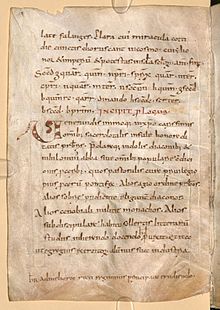Hygeburg

Hygeburg (floruit 760–780), also Hugeburc, Hugeberc, Huneberc or Huneburc, was an Anglo-Saxon nun and hagiographer at the Alemannian monastery of Heidenheim. She is "the first known Englishwoman to have written a full-length literary work"[1] and "the only woman author of a saint's life from the Carolingian period".[2]
Heidenheim was founded as a monastery for monks in 752 by Wynnebald, an Anglo-Saxon from Wessex.[1] On his death in 761, his sister Walburg inherited it and converted it into a double monastery with the introduction of nuns.[1] Hygeburg was among those who came to Heidenheim immediately after Wynnebald's death.[1] Probably she had already been in Germany for some time, one of the nuns summoned by Boniface.[1]
Hygeburg was, in her own words, "a humble relative" of Wynnebald, Walburg and their brother, Willibald.[1] On Tuesday, 23 June 778, while he was visiting Heidenheim, Willibald dictated to Hygeburg an account of his pilgrimage to the Holy Land in the 720s[2] or 730s.[1] She subsequently worked this account into a biography of Willibald,[1] called the Hodoeporicon ("relation of a voyage").[2] (The conventional name Vita Willibaldi, "Life of Willibald", was given to it by editors.[3]) From her choice of phrase and motif, she must have had access to the Carmen paschale, the Vita Bonifatii and the riddles of Aldhelm.[1]
Although there was opposition to her writing within the convent, Walburg encouraged it. Hygeburg also wrote a biography of Wynnebald, the Vita Wynnebaldi.[1] Although her two works were a single project, completed by 780, they are textually distinct, indicating her use of oral reports and eyewitness testimony.[1] She was herself a witness to some of the post-mortem miracles she attributes to Wynnebald's intervention.[1]
The name of the nun who wrote the lives of Willibald and Wynnebald was not known until in 1931 Bernhard Bischoff discovered it in a cryptogram in the oldest manuscript (from c. 800).[1]
References[edit]
- ^ a b c d e f g h i j k l m Carolyne Larrington. "Hugeburc". Oxford Dictionary of National Biography (online ed.). Oxford University Press. doi:10.1093/ref:odnb/49413. (Subscription or UK public library membership required.)
- ^ a b c Huneberc of Heidenheim (C. H. Talbot, trans.), "The Hodoeporicon of Saint Willibald", in Thomas F. X. Noble and Thomas Head, eds., Soldiers of Christ: Saints and Saints' Lives from Late Antiquity and the Early Middle Ages (Pennsylvania State University Press, 1995), pp. 141–42.
- ^ Maribel Dietz, Wandering Monks, Virgins, and Pilgrims: Ascetic Travel in the Mediterranean World, A.D. 300–800 (Pennsylvania State University Press, 2005), p. 209 n85.
Further reading[edit]
- Lapidge, M., "Hygeburg", in M. Lapidge et al., The Blackwell Encyclopedia of Anglo-Saxon England. Blackwell, 1999. ISBN 0-631-22492-0
